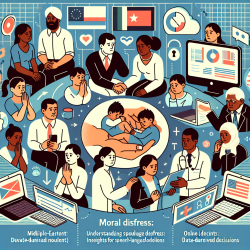Empowering Practitioners to Foster Resilience in Children
The COVID-19 pandemic has undeniably reshaped the landscape of mental health, particularly among children. As practitioners dedicated to nurturing the well-being of young minds, it is crucial to harness data-driven insights to enhance therapeutic outcomes. A recent study, "A longitudinal investigation of psychological distress in children during COVID-19: the role of socio-emotional vulnerability," provides valuable guidance on how socio-emotional factors influence children's mental health during crises. Let's explore how these findings can empower practitioners to foster resilience and better support children through online therapy services like those offered by TinyEYE.
Understanding Socio-Emotional Vulnerability
The study highlights the significance of socio-emotional vulnerability in predicting psychological distress among children during the pandemic. Socio-emotional vulnerability is a composite measure encompassing anxiety sensitivity, trait anxiety, intolerance to uncertainty, and rumination. The research found that children with higher socio-emotional vulnerability scores exhibited elevated anxiety and post-traumatic stress (PTS) symptoms, although depressive symptoms were not significantly affected.
For practitioners, understanding these socio-emotional predictors is essential in tailoring interventions that address the unique needs of each child. By recognizing these vulnerabilities, therapists can implement targeted strategies to mitigate anxiety and PTS symptoms, ultimately fostering resilience in children.
Implementing Research Insights in Practice
Practitioners can leverage the study's findings to enhance their therapeutic approach in several ways:
- Screening and Assessment: Incorporate assessments that evaluate socio-emotional vulnerability factors, such as anxiety sensitivity and intolerance to uncertainty, to identify children at higher risk of distress.
- Customized Interventions: Develop personalized intervention plans that focus on reducing anxiety and PTS symptoms by addressing specific socio-emotional vulnerabilities.
- Parental Involvement: Engage parents in the therapeutic process to ensure a supportive environment that reinforces coping strategies and resilience-building activities.
- Continuous Monitoring: Utilize data-driven tools to monitor progress and adjust interventions as needed, ensuring that therapy remains responsive to the child's evolving needs.
Encouraging Further Research
While the study provides valuable insights, it also underscores the need for continued research to fully understand the complex interplay of socio-emotional factors in children's mental health. Practitioners are encouraged to contribute to this growing body of knowledge by conducting longitudinal studies and sharing findings with the broader community. By doing so, we can collectively enhance our understanding and improve therapeutic outcomes for children worldwide.
Conclusion
As practitioners, our commitment to data-driven decision-making and evidence-based practices is paramount in creating positive outcomes for children. By integrating the insights from this study into our therapeutic approaches, we can empower children to navigate challenges with resilience and confidence. To read the original research paper, please follow this link: A longitudinal investigation of psychological distress in children during COVID-19: the role of socio-emotional vulnerability.










